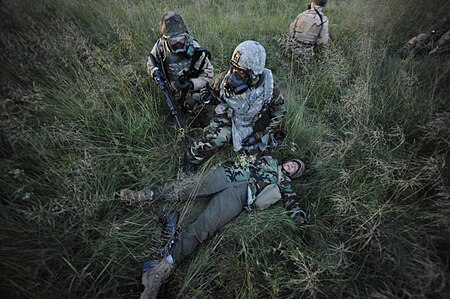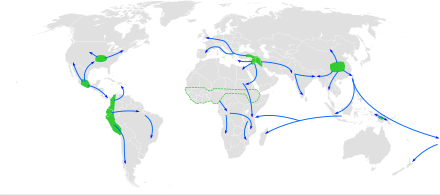Pre-Pottery Neolithic A
| |||||||||||||||
Read other articles:

Dua orang yang sedang memperagakan jurus monsak Monsak (dibaca: Mossak atau Moccak) [1], Beladiri Silat dan Mossak, tidak selalu digunakan untuk menyerang sesama manusia atau makhluk lain. Tarian dan ilmu beladiri ini, kini lebih ditekankan kepada persembahan tarian pada upacara adat itu sendiri. Dan Mossak merupakan ilmu beladiri yang berasal dari Tanah Batak dan mungkin saat ini sangat tidak mudah dan jarang akan menemui praktisi atau mungkin acara adat yang secara langsung dan profess…

Kereta api Cianjuran adalah rangkaian kereta api kelas bisnis dua rangkaian yang ditarik oleh sebuah lokomotif BB 301 atau BB 304. Kereta api CianjuranKereta api Cianjuran melintasi jalan raya di PadalarangInformasi umumJenis layananKereta api jarak pendekStatusTidak BeroperasiDaerah operasiPT. Kereta Api Indonesia Daerah Operasi II BandungTerakhir beroperasi25 April 2013Lintas pelayananJumlah pemberhentian10Pelayanan penumpangKelasBisnisPengaturan tempat duduk? (kemungkinan 64 kursi yang disusu…

Untuk kegunaan lain, lihat Michaelmas (disambiguasi). Perayaan Santo Mikael, Gabriel, RafaelSanto Mikael Malaikat AgungDirayakan oleh Gereja Katolik Persekutuan Anglikan[1] Komunitas Steiner/Waldorf Lutheranisme Tanggal29 September (Gereja Barat)[2] 8 November (Gereja Timur)[3]Frekuensitahunan Michaelmas (/ˈmɪkəlməs/ mik-ƏL-məs; juga dikenal sebagai Perayaan Santo Mikael, Gabriel, dan Rafael, Perayaan Malaikat Agung, atau Perayaan Santo Mikael dan Seluruh Malaikat, …

Bordeaux-Mérignac AirportAéroport de Bordeaux-MérignacIATA: BODICAO: LFBD BODLocation of airport in AquitaineInformasiJenisPublic / MilitaryMelayaniBordeaux, PrancisLokasiMérignac, PrancisKetinggian dpl49 mdplKoordinat44°49′42″N 000°42′56″W / 44.82833°N 0.71556°W / 44.82833; -0.71556Situs webwww.bordeaux.aeroport.frLandasan pacu Arah Panjang Permukaan m kaki 05/23 3,100 10,171 Aspal 11/29 2,415 7,923 Aspal Statistik (2011)Penumpang4,117,200Source…

Kucing batu[1] Pardofelis marmorata Status konservasiRentanIUCN16218 TaksonomiKerajaanAnimaliaFilumChordataKelasMammaliaOrdoCarnivoraFamiliFelidaeGenusPardofelisSpesiesPardofelis marmorata (William Charles Linnaeus Martin, 1837) Tata namaProtonimFelis marmorata Subspecies P. m. charltoni P. m. marmorata DistribusiPersebaran kucing batu lbs Kucing batu (Pardofelis marmorata) adalah kucing liar kecil dari Asia Selatan dan Asia Tenggara. Sejak 2002, ia terdaftar dalam spesies rentan olhe IU…

Cheongyang 청양Kabupaten (Gun)Transkripsi Korea • Hangul청양군 • Hanja靑陽郡 • Alih Aksara yang DisempurnakanCheongyang-gun • McCune-ReischauerCh'ŏngyang-gun Emblem dari CheongyangLokasi di Korea SelatanNegara Korea SelatanWilayahHoseoPembagian administratif1 eup, 9 myeonLuas • Total479,57 km2 (185,16 sq mi)Populasi (2003) • Total37.194 • Kepadatan77,6/km2 (201/sq mi)&#…

Perjanjian RastattPeta Eropa setelah penandatanganan Perjanjian Utrecht, Rastatt, dan BadenKonteks Mengakhiri Perang Pewaris Spanyol Ditandatangani7 Maret 1714 (1714-03-07)LokasiRastatt, Markgrafschaft Baden-BadenPerunding Claude Louis, Adipati Villars Pangeran Eugene dari Savoia Pihak Kerajaan Prancis Habsburg Monarchy (Austria) BahasaPrancis Perjanjian Rastatt adalah sebuah perjanjian perdamaian yang ditandatangani oleh Kerajaan Prancis dan Austria pada tanggal 7 Maret 1714 di…

العلاقات البريطانية الفنلندية المملكة المتحدة فنلندا المملكة المتحدة فنلندا تعديل مصدري - تعديل العلاقات البريطانية الفنلندية هي العلاقات الثنائية التي تجمع بين المملكة المتحدة وفنلندا.[1][2][3][4][5] مقارنة بين البلدين هذه مقارنة عامة وم�…

Politique commune de l'immigration Description Espace de convergence des législations nationales des États membres de l'Union européenne Administration Traité Article 79 du TFUE modifier La politique commune de l'immigration de l'Union européenne commencé à se développer à partir de l'intégration de l'acquis de Schengen dans le droit de l'Union européenne[1] et le constat selon lequel l'Union européenne est devenue l'une des principales régions de destination des voies migrato…
The Coral Island Halaman judul edisi berilustrasi 1893PengarangR. M. BallantyneBahasaInggrisGenrePetualanganDiterbitkan1857Jenis mediaCetakTeks asli The Coral Island at Inggris Wikisource The Coral Island: A Tale of the Pacific Ocean (Indonesia: Pulau Koral: Sebuah Kisah Samudra Pasifikcode: id is deprecated ) adalah novel tahun 1857 karya pengarang Skotlandia R. M. Ballantyne. Sebagai salah satu karya fiksi remaja pertama yang secara khusus menampilkan pahlawan remaja, cerita di dalamnya m…

يفتقر محتوى هذه المقالة إلى الاستشهاد بمصادر. فضلاً، ساهم في تطوير هذه المقالة من خلال إضافة مصادر موثوق بها. أي معلومات غير موثقة يمكن التشكيك بها وإزالتها. (يوليو 2020) دوري البطولة الإنجليزية 1950 تفاصيل الموسم دوري البطولة الإنجليزية [لغات أخرى] النسخة 41 البل�…

Census-designated place named North Potomac in Maryland, United States Census-designated place in Maryland, United StatesNorth Potomac, MarylandCensus-designated placeCoordinates: 39°05′50″N 77°14′54″W / 39.09722°N 77.24833°W / 39.09722; -77.24833CountryUnited StatesState MarylandCounty MontgomeryArea[1] • Total6.56 sq mi (16.99 km2) • Land6.52 sq mi (16.89 km2) • Water0.04 sq&…

Keladi Caladium bicolor 'Florida Sweetheart' Klasifikasi ilmiah Kerajaan: Plantae (tanpa takson): Tracheophyta (tanpa takson): Angiospermae (tanpa takson): Monokotil Ordo: Alismatales Famili: Araceae Genus: CaladiumVent. Spesies Lihat teks. Keladi merupakan sekelompok tumbuhan dari genus Caladium, suku talas-talasan (Araceae). Dalam bahasa sehari-hari keladi kerap juga dipakai untuk menyebut beberapa tumbuhan lain yang masih sekerabat namun tidak termasuk Caladium, seperti talas (Colocasia). Kel…

Association football club in Alfreton, England Football clubAlfreton TownFull nameAlfreton Town Football ClubNickname(s)The RedsFounded1959GroundNorth Street, AlfretonCapacity3,600 (1,500 seated)[1]Coordinates53°05′40″N 1°22′53″W / 53.09444°N 1.38139°W / 53.09444; -1.38139ChairmanWayne BradleyManagerBilly HeathLeagueNational League North2023–24National League North, 5th of 24WebsiteClub website Home colours Away colours Alfreton Town Football Club is…

A youth organization in Iran You can help expand this article with text translated from the corresponding article in Persian. (February 2009) Click [show] for important translation instructions. View a machine-translated version of the Persian article. Machine translation, like DeepL or Google Translate, is a useful starting point for translations, but translators must revise errors as necessary and confirm that the translation is accurate, rather than simply copy-pasting machine-translated…

Swedish death metal band This article needs additional citations for verification. Please help improve this article by adding citations to reliable sources. Unsourced material may be challenged and removed.Find sources: Grave band – news · newspapers · books · scholar · JSTOR (July 2008) (Learn how and when to remove this message) GraveGrave at Party.San Metal Open Air 2016Background informationAlso known asCorpsePutrefactionOriginGrisknullarbyn, Vis…

Artery of the neck Inferior thyroid arteryThyrocervical trunk and its branches, including inferior thyroid artery. Superficial dissection of the right side of the neck.Human parathyroid glandsDetailsSourceThyrocervical trunkVeinInferior thyroid veinsSuppliesThyroid glandIdentifiersLatinarteria thyreoidea inferiorTA98A12.2.08.043TA24591FMA10662Anatomical terminology[edit on Wikidata] The inferior thyroid artery is an artery in the neck. It arises from the thyrocervical trunk and passes upward…

Seorang India sedang memainkan sitar; ilustrasi dari abad ke-18 Sitar (Urdu/Persia: سهتار ṣītār, Hindi: सितार) adalah salah satu jenis alat musik yang berasal dari Asia Selatan. Alat musik klasik Hindustan yang menggunakan dawai/senar. Alat musik ini menggunakan dawai simpatetik bersama dengan dawai biasa dan ruang resonansi menggunakan gourd (sejenis buah-buahan yang dikeringkan dan berongga di dalamnya) sehingga menghasilkan suara yang unik. Sitar merupakan alat musik yan…

This article is about the 633rd Air Base Wing. For the 633d Special Operations Wing, see 633d Special Operations Wing. This article needs additional citations for verification. Please help improve this article by adding citations to reliable sources. Unsourced material may be challenged and removed.Find sources: 633rd Air Base Wing – news · newspapers · books · scholar · JSTOR (January 2013) (Learn how and when to remove this message) 633d Air Base Wing M…

温贝托·德·阿连卡尔·卡斯特洛·布兰科Humberto de Alencar Castelo Branco第26任巴西總統任期1964年4月15日—1967年3月15日副总统若澤·馬利亞·奥克明前任拉涅里·馬齐利继任阿图尔·达科斯塔·伊·席尔瓦 个人资料出生(1897-09-20)1897年9月20日 巴西塞阿腊州福塔雷萨逝世1967年7月18日(1967歲—07—18)(69歲) 巴西塞阿腊州梅塞雅納墓地 巴西福塔雷薩卡斯特洛·布兰科陵寢[1]国…






![The Urfa Man c. 9000 BCE.[13][14][15] Şanlıurfa Archaeology and Mosaic Museum.](http://upload.wikimedia.org/wikipedia/commons/thumb/b/b7/Urfa_man.jpg/120px-Urfa_man.jpg)


